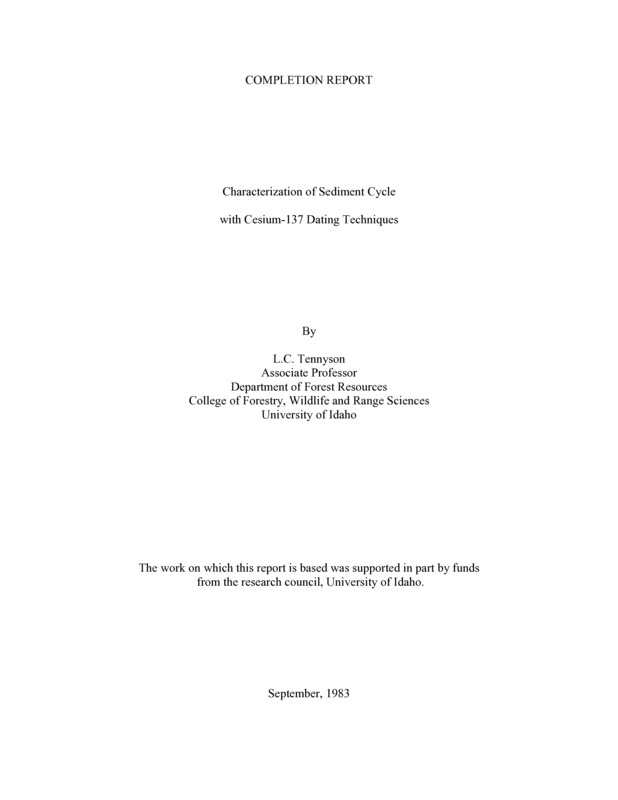PDF PREVIEW
Completion Report - Characterization of Sediment Cycle with Cesium-137 Dating Techniques Item Info
Download Preview PDF
Please note: PDF file may not be complete document.
- Title:
- Completion Report - Characterization of Sediment Cycle with Cesium-137 Dating Techniques
- Creator:
- Tennyson, L.C.
- Date Created:
- 1983-09
- Description:
- The ever increasing demand for utilization of the land resource has generated concern about the potential for accelerated erosion associated with land use activities. Erosion is a natural process; however, land use activities often produce comparatively higher erosion rates. Soil particles detached from the land surface by flowing water can be delivered to nearby channels and transported to man-made water storage structures located downstream. The life spa of municipal, agriculture, and hydroelectric water supply reservoirs is often shortened because of accelerated deposition of sediments produced by increased upslope erosion associated with land use. Quantification of the rate of detachment, transport, and deposition of sediments, as related to natural and disturbed watershed conditions, is necessary if conservation of the soil resource is to be obtained and existing water reservoirs are to be protected. Continued research efforts are needed to develop and improve existing methods for quantifying the degree of erosion and rate of sediment deposition. One method of determining the rate of removal and deposition of sediments is to follow the fate of tagged sediments through the sedimentation cycle. A measurable tracer which is present in the existing environment and moves with detached sediment particles can be used to estimate the degree of eroded and deposited sediments on a watershed. Measurement of the concentration of the tracer on disturbed and undisturbed soil surfaces and in deposited reservoir sediments permits an assessment of erosion-deposition as related to degree of land use. The atmospheric nuclear explosions which occurred in the late 1950’s and early 1960’s produced fallout of several radioisotopes which were dispersed onto the land surface of the earth. One of these isotopes, Cesium-137, is strongly absorbed by most soil particles (Ritchie et al. 1973). Because of this absorption phenomena and the 330year half-life of this isotope a majority of 137Cs which has fallen to the earth’s surface is still present in the upper layers of the soil profile. The relative location and concentration of 137Cs in the soil or deposited soil profile can be used to assess the rate of soil particle detachment and deposition. Reservoir sediments deposited since the early 1950’s would have two distinct peaks of 137Cs accumulation which correspond to the 1959-60 and1962-64 period of maximum cesium fallout (HASL 1977). A third peak should also be present from fallout produced by the Chinese atmospheric nuclear detonation which occurred in 1976 (HASL 1976). Sediments deposited between these peak periods would have 137Cs present, but in lesser quantities. Similar analysis can be applied to watershed surfaces in the context of presence or absence of peak levels of isotope in the soil profile. Research conducted in the southern portion of the United States by Ritchie et al. (1973) and McHenry et al. (1973) indicate that 137Cs can be detected in soil and sediment profiles. These researchers were able to identify peak periods of 137Cs accumulation in soil and reservoir sediments. Atmospheric fallout records for Seattle and Forks, Washington, and Helena, Montana (Figure 2), indicate that sufficient levels of 137Cs have accumulated at the earth’s surface in the western United States to be quantified by gamma-ray spectrometric analysis (HASL 1977). Cesium-137 was measured in soil in eastern Montana at concentrations ranging from 0.524 to 2.217 nCi/Kg (McHenry et al. 1983). This project was designed to conduct a preliminary investigation of 137Cs levels in soils and deposited sediments at selected locations in northern Idaho and to assess the feasibility of using 137Cs as a sediment tracer. The objectives of the study were to: 1. Identify and quantify the distribution of 137Cs in disturbed and undisturbed soil profiles and in lake sediment cores. 2. Assess the feasibility of using 137Cs as a sediment tracer for evaluating the surface movement and storage components of the sedimentation cycle.
- Document Type:
- Research Report
- Subjects:
- Big Meadow Creek soils deposition sediment deposition erosion watershed management Cesium-137 sediment transport rate of detachment soils
- UIEF Unit:
- Big Meadow Creek
- Section:
- SW 1/4 S23
- Township:
- T40N
- Range:
- R4W
- Location:
- UIEF; Big Meadow Creek
- Latitude:
- 46.799488
- Longitude:
- -116.812869
- Department:
- Department of Forest Resources
- Type:
- Text
- Format:
- application/pdf
Source
- Preferred Citation:
- "Completion Report - Characterization of Sediment Cycle with Cesium-137 Dating Techniques", UIEF Research Exchange, University of Idaho Library Digital Collections, https://www.lib.uidaho.edu/digital/uief/items/uief_0068.html
Rights
- Rights:
- In copyright, educational use permitted.
- Standardized Rights:
- http://rightsstatements.org/vocab/InC-EDU/1.0/

